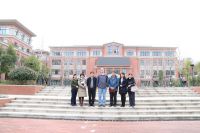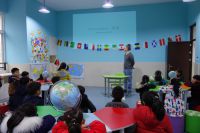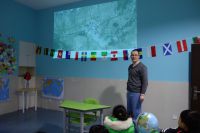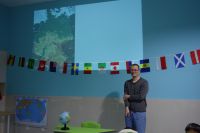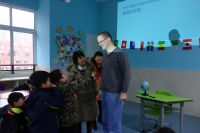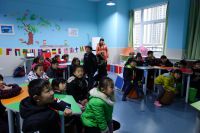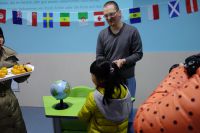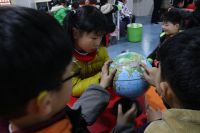On March 6 and 13, 2018, I had the chance to give two one-hour introduction lessons on German culture to the students of the Nanmen Primary School [南门小学] [(森林公园校区)]. Before going there, I wondered how and what should I teach elementary school children about German culture? What could they be interested to learn? This was an interesting challenge.
We started by finding out where Germany is. I wanted to put this in a context of something the school children can relate to, so we began a virtual journey to Germany in Hefei [合肥]. We looked at satellite images and "zoomed" farther and farther out, until other cities and the whole of the Anhui [安徽] province and then all of China and its neighboring countries became visible. We then flew over the globe until arriving in Europe, where we zoomed in again on Germany. We then compared the size and population of Germany to Anhui and China. Comparing with Anhui makes sense, because here the scales are quite similar: Germany is about 2.5 times as big there are eight German people for every seven Anhui people. China is 27 times as big as Germany and has 17.5 times as many people. We then learned how German people look like and what clothes they wear. We looked at photos of typical German people of various professions, ranging from scientists, elementary school children, bakers, police people, fire fighters, sports persons, cashiers in a super market, farmers, and fisher people. The children liked that we have many different hair colors, such as blond, brown, black, and red. Finally, we talked about Christmas and the traditions around it, including Christmas trees and Santa Claus. And then our first lesson was already over.
In the second lesson, we continued to look into the German holidays related to Children and discussed Silvester/New Year, Eastern, Fasching (the German carnival), the Children's day, Mother's day, and how birthdays are celebrated. Finally, we found out what German people eat: Different from Chinese, who like to warm/freshly cooked food for all three meals, German people usually warm only for lunch and cold food for breakfast and dinner. Then, we eat bread covered with butter on top of which we put either sausages or cheese. A typical German lunch often involves potatoes and, again, meat. After having discussed typical German dishes (and that Chinese often perceive them as too sour), the second lesson was over, too.
Teaching a class of primary school children about my culture was a very nice experience. The children were very curious, attentive, and asked interesting questions. Also I want to thank the teachers Mrs. Yang [杨老师] and Mrs. Cheng [程老师] for their support and for translating the class.
I also found that this primary school to be a very good example about the resources and efforts that China is investing in education. It does not only have a very nice and green campus, but also offers many extracurricular activities to the pupils, including, for instance, singing, dancing, painting, playing musical instruments — and the international culture class. And for each activity, there is a special, dedicated and nicely decorated room with the right equipment.
See also: http://www.hfnx.com/DocHtml/1/Article_2018374665.html



